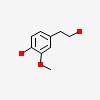Articles:
benzeneethanol, 4-hydroxy-3-methoxy-
Notes:
metabolite of serotonin and norepinephrine. Isol. from various plant spp. Constit. of mandibular secretion of honeybees [CCD]
| CAS Number: | 2380-78-1 |  3D/inchi 3D/inchi
|
| ECHA EINECS - REACH Pre-Reg: | 219-175-1 | |
| FDA UNII: | 9A7EE8MS6A | |
| Nikkaji Web: | J172D | |
| MDL: | MFCD00002903 | |
| XlogP3: | 0.50 (est) | |
| Molecular Weight: | 168.19224000 | |
| Formula: | C9 H12 O3 | |
| NMR Predictor: | Predict (works with chrome or firefox) | |
Category: flavor and fragrance agents
US / EU / FDA / JECFA / FEMA / FLAVIS / Scholar / Patent Information:
| Google Scholar: | Search |
| Google Books: | Search |
| Google Scholar: with word "volatile" | Search |
| Google Scholar: with word "flavor" | Search |
| Google Scholar: with word "odor" | Search |
| Perfumer and Flavorist: | Search |
| Google Patents: | Search |
| US Patents: | Search |
| EU Patents: | Search |
| Pubchem Patents: | Search |
| PubMed: | Search |
| NCBI: | Search |
Physical Properties:
| Assay: | 98.00 to 100.00 % |
| Food Chemicals Codex Listed: | No |
| Melting Point: | 40.00 to 42.00 °C. @ 760.00 mm Hg |
| Boiling Point: | 316.00 to 317.00 °C. @ 760.00 mm Hg (est) |
| Vapor Pressure: | 0.000169 mmHg @ 25.00 °C. (est) |
| Flash Point: | > 230.00 °F. TCC ( > 113.00 °C. ) |
| logP (o/w): | 0.470 |
| Soluble in: | |
| alcohol | |
| water, 8.053e+004 mg/L @ 25 °C (est) | |
Organoleptic Properties:
| Odor and/or flavor descriptions from others (if found). | |
Cosmetic Information:
| None found |
Suppliers:
| BOC Sciences |
| For experimental / research use only. |
| Homovanillyl alcohol >95%
Odor: characteristic Use: Homovanillyl alcohol is a natural phenolic compound found in strawberries, grapes and olive oil. Homovanillyl alcohol shows high scavenging activities and can inhibit homocysteine-induced endothelial cell adhesion. |
| Santa Cruz Biotechnology |
| For experimental / research use only. |
| homoVanillyl Alcohol 99% |
| Sigma-Aldrich: Aldrich |
| For experimental / research use only. |
| homoVanillyl alcohol 99% |
Safety Information:
| Preferred SDS: View | |
| Hazards identification | |
| Classification of the substance or mixture | |
| GHS Classification in accordance with 29 CFR 1910 (OSHA HCS) | |
| None found. | |
| GHS Label elements, including precautionary statements | |
| Pictogram | |
| Hazard statement(s) | |
| None found. | |
| Precautionary statement(s) | |
| None found. | |
| Oral/Parenteral Toxicity: | |
| Not determined | |
| Dermal Toxicity: | |
| Not determined | |
| Inhalation Toxicity: | |
| Not determined | |
Safety in Use Information:
| Category: | flavor and fragrance agents | ||
| IFRA Code of Practice Notification of the 49th Amendment to the IFRA Code of Practice | |||
Safety References:
| EPI System: | View |
| Cancer Citations: | Search |
| Toxicology Citations: | Search |
| EPA ACToR: | Toxicology Data |
| EPA Substance Registry Services (SRS): | Registry |
| Laboratory Chemical Safety Summary : | 16928 |
| National Institute of Allergy and Infectious Diseases: | Data |
| WGK Germany: | 3 |
| 4-(2-hydroxyethyl)-2-methoxyphenol | |
| Chemidplus: | 0002380781 |
References:
| 4-(2-hydroxyethyl)-2-methoxyphenol | |
| NIST Chemistry WebBook: | Search Inchi |
| Pubchem (cid): | 16928 |
| Pubchem (sid): | 134981594 |
Other Information:
| (IUPAC): | Atomic Weights of the Elements 2011 (pdf) |
| Videos: | The Periodic Table of Videos |
| tgsc: | Atomic Weights use for this web site |
| (IUPAC): | Periodic Table of the Elements |
| HMDB (The Human Metabolome Database): | HMDB38925 |
| FooDB: | FDB018391 |
| YMDB (Yeast Metabolome Database): | YMDB01712 |
| Export Tariff Code: | 2909.50.4500 |
| VCF-Online: | VCF Volatile Compounds in Food |
| ChemSpider: | View |
| Wikipedia: | View |
Potential Blenders and core components note
| None Found | ||
Potential Uses:
| None Found |
Occurrence (nature, food, other): note
| apis mellifera capensis Search Trop Picture |
Synonyms:
| benzeneethanol, 4-hydroxy-3-methoxy- | |
| 4- | hydroxy-3-methoxyphenethanol |
| 4- | hydroxy-3-methoxyphenethyl alcohol |
| 2-(4- | hydroxy-3-methoxyphenyl)ethanol |
| 4- | hydroxy-3-methoxyphenylethyl alcohol |
| 4-(2- | hydroxyethyl) guaiacol |
| 4-(2- | hydroxyethyl)-2-methoxyphenol |
| 4-(2- | hydroxyethyl)-2-methoxyphenol |
| 4-(2- | hydroxyethyl)guaiacol |
| 3- | methoxy-4-hydroxyphenylethanol |
| homo | vanillin alcohol |
| homo | vanillylalcohol |
